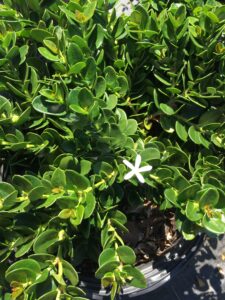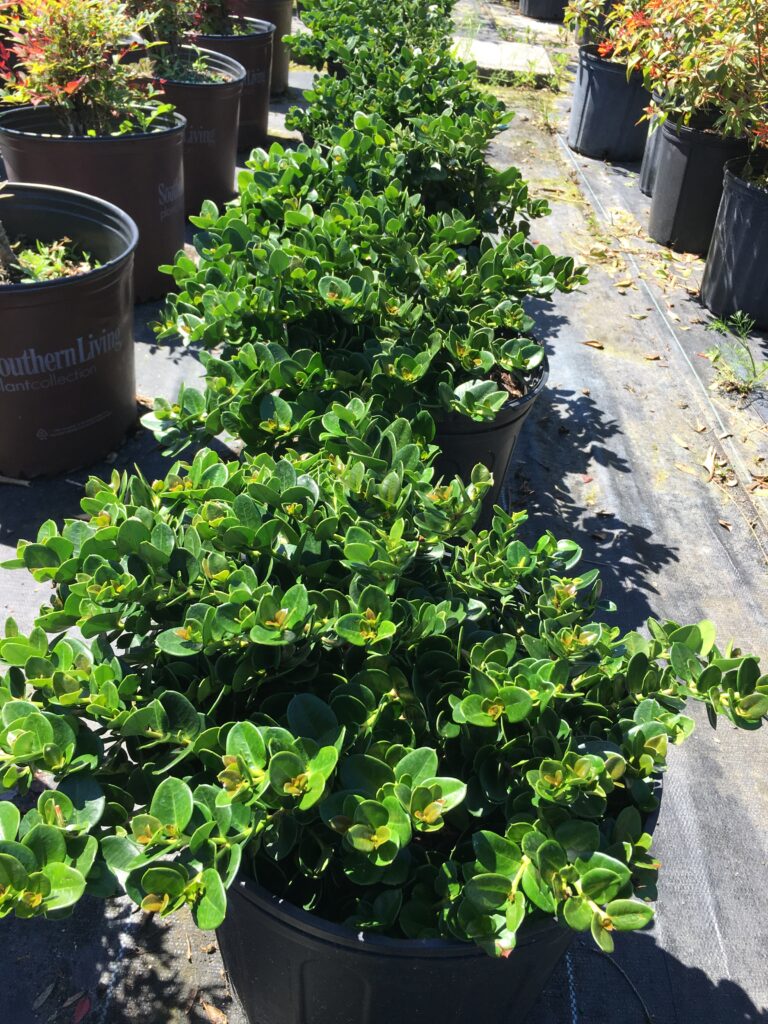Growing Carissa Dwarf Natal Plum Carissa macrocarpa shrubs for the Northeast Florida, Jacksonville, St. Augustine and surrounding areas

Origins of Dwarf Natal Plum / Carissa macrocarpa:
– Carissa macrocarpa is native to Southern Africa and well suited to coastal areas tolerating salt air and ground salts well. These hardy groundcover shrubs can tolerate temperatures down to 25F but young plants may need protection under 29F. I have personally trialed these shrubs in my home garden in St Johns Florida and instantly fell in love with them. They are tuff as nails and absolutely beautiful year round with little to no pest problems and low maintenance needs.
Preferred Exposure for Dwarf Natal Plum / Carissa macrocarpa :
– Dwarf natal Plum can be planted into full sun or part sun / part shade situations here in the Northeast Florida, Jacksonville | St. Augustine area landscape.
Foliage of the Dwarf Natal Plum / Carissa Macrocarpa:
– Small foliage is a bright, glossy medium to deep green color, with copper colored new growth at the tips of branches. Plants will be evergreen in our subtropical climate zone for Jacksonville and St. Augustine areas of Northeast Florida.
Adds texture to the garden and contrasts well with larger foliage plants.
Soil Preference and Salt tolerance of Carissa / Dwarf Natal Plum :
– Dwarf Natal Plum / Carissa will prefer dry sandy well drained soils and are quite drought tolerant when established into the landscape.
– avoid planting in areas that remain water logged after rains for prolonged periods as the roots will begin to rot in heavily wet soils.
- not particular about soil components and grow equally as well in sandy soils as they do in clay and loam providing drainage is adequate.
– Dwarf Natal Plum/ Carissa shrubs have a high salt tolerance and make an excellent shrub or groundcover for coastal
plantings.
Size Variance of Dwarf Natal Plum:
– Carissa macrocarpa can reach sizes of 12-18 inches in height and can spread 2-8 ft wide although they can be easily maintained at about a 2 ft width with just yearly trimming.
Space plants at a minimum of 3 ft from the center of one plant to the center of another for foundation plantings.
Growth Habit of Carissa macrocarpa:
– Dwarf Natal Plum has a wide low spreading growth habit and stays tight to the ground.
Growth Rate of the Dwarf Natal Plum:
– Fast growing shrub quickly establishes itself into the landscape.
Blooms / Fruits of the Dwarf Natal Plum:
– Dwarf Natal plum is known for its white flowers and round red fruits that are edible but they rarely produce them in our Northeast Florida landscapes. Further south they will get star shaped flowers and fruits like their taller shrub counter parts the Natal Plum / Carissa grandiflora.
Water Requirements of Dwarf Natal Plum :
– Natal Plum Dwarf are fairly low water and drought tolerant once they are established into the landscape. Remember to check their water needs daily after planting to get them rooted and established into the landscape quickly.
– Watering your newly planted smaller shrubs and flowers
Butterfly or Bird Attracting:
– Attracts butterflies hummingbirds and other pollinators to the garden. Long season blooms provide and excellent nectar source.

Best Uses For Dwarf Natal Plum / Carissa macrocarpa:
– Dwarf Natal Plum is a dwarf or compact selection that will be best used as the smallest layer of home foundation plantings. Escellent as an accent around focal point specimen trees and when used as a groundcover, tends to stay tight to the ground and shade out weeds making it an easy low maintenance shrub selection.
Care of S & J Nursery’s North Florida | Jacksonville | St. Augustine Dwarf Natal Plum
Shrubs:
– Carissa should be pruned once a year to shape when they begin to be sprawl out of bounds. Do not be afraid to trim, they resprout new growth quickly and bloom on that new growth! They may be trimmed at any time during the spring summer or early fall months. If you trim late in fall or winter time the plant will flush new growth that may not have time to harden off before it is exposed to a cold snap and will be unsightly all winter long. A good rule of thumb for the North Florida are is not to prune in the late fall, wait until the weather warms in spring and give them a good trim, once they have bloomed and grown you may opt for another ‘haircut’ during mid summer to shape it up a bit.
– Natal Plum Dwarf Carissa macrocarpa shrubs can be planted in the North Florida | Jacksonville | St. Augustine area at any time during the year. In normal and well draining soils dig the hole as deep as the root ball and two to three times as wide. Plant the top of the root ball level or slightly higher than the surrounding soils. Avoid planting in poorly drained soils.
– Check the plants water needs every day during the establishment period. For most 3 gallon size shrubs in the North Florida landscape in average soil, that is neither heavy clay that holds water or really sandy that will take 2-3 weeks of daily watering to ensure that your newly planted shrub will begin to put out new roots and grow into its new home happily. After the first few weeks begin tapering back your watering to every other day then every third day and so on until your newly planted items are flourishing without your assistance.
– Carissa may need supplemental irrigation during times of excessive heat or drought.
– IMPORTANT: If planting shrubs in heavy clay soils that hold allot of water after a rain or irrigating, remember to check the soil for moisture by sticking your fingers into the soil near the root ball of the newly planted shrub down to 2-3 inches. If it remains wet from the previous watering wait for the top 2-3 inches to dry out before watering again.
– IMPORTANT: When planting shrubs into poor sandy soils be sure to amend the planting hole by mixing compost or cow manure etc. with the native soil that will go back in the hole around the new plants root ball when installing your shrub material, this will not only give your new shrubs good soil to grow its new roots into but help it hold water.
– When planting shrubs from containers be sure to loosen the roots as much as possible pulling loose roots away from the root ball before installing your new plants, if the roots are to tight to easily loosen with your hands use a knife to cut a few slits into the root ball being careful to go all
the way from the top to the bottom and making the cut at least an inch deep. This will ensure that your plant will immediately begin to form new roots into its new surrounding soil.
Planting your new smaller shrubs and flowering plants
– Mulch newly planted shrubs whenever possible. Shrubs will benefit from a 3-4 inch layer of arborists wood chips, Pine bark or Pine Straw.
– Fertilize each spring with a shovelful of good garden compost or a good quality slow release poly coated plant food like Stay Green or Osmocote. Be sure when fertilizing to sprinkle the fertilizer around the mulch circle underneath the foliage of the shrubs.

